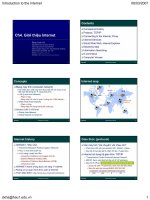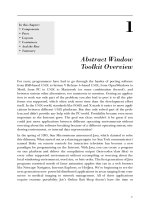Tài liệu Introduction to Quality of Service pdf
Bạn đang xem bản rút gọn của tài liệu. Xem và tải ngay bản đầy đủ của tài liệu tại đây (625.96 KB, 25 trang )
Copyright © 2000, Cisco Systems, Inc. 1
© 2000, Cisco Systems, Inc.
Introduction to
Quality of Service
Introduction to
Quality of Service
Copyright © 2000, Cisco Systems, Inc. 2
© 2000, Cisco Systems, Inc. www.cisco.com Econ_0385_02_010.ppt
Keep All Graphics Inside This Box
Objectives
Objectives
Upon completion of this module, you will be
able to perform the following tasks:
• Explain the significance of Quality of Service (QoS)
• Describe new Quality of Service (QoS) features in
Cisco IOS 12.1
• Explain which problems QoS solves
The purpose of this module is to quickly survey the new Quality of Service (QoS)
features in Cisco IOS 12.1 and to describe the problems they solve..
Copyright © 2000, Cisco Systems, Inc. 3
© 2000, Cisco Systems, Inc. www.cisco.com Econ_0385_02_010.ppt
Keep All Graphics Inside This Box
Topics
Topics
QoS overview
New QoS features
Quick look at Diff Serv framework
Copyright © 2000, Cisco Systems, Inc. 4
© 2000, Cisco Systems, Inc. www.cisco.com Econ_0385_02_010.ppt
Keep All Graphics Inside This Box
Why Is QoS So Important?
Why Is QoS So Important?
QoS:
• Allows the integration of data, voice, and
video over the network
• Mission-critical traffic can be prioritized
over non-critical traffic
–Certain business applications
–Voice, SNA traffic
• Can prioritize different groups of users ,
such as finance, sales, or suppliers
The Cisco IOS QoS features enable networks to control and predictably service a
variety of networked applications and traffic types. Implementing Cisco IOS QoS
in your network promotes the following:
• Control over resources—You control which resources (bandwidth, equipment,
wide-area facilities, and so on) are being used. For example, you can limit
bandwidth consumed over a backbone link by File Transfer Protocol (FTP)
transfers or give priority to an important database access.
• Tailored services—If you are an Internet Service Provider (ISP), the control
and visibility provided by QoS enables you to offer carefully tailored grades of
service differentiation to your customers.
• Coexistence of mission-critical applications.
Cisco QoS features make certain of the following:
• That your WAN is used efficiently by mission-critical applications that are
most important to your business.
• That bandwidth and minimum delays required by time-sensitive multimedia
and voice applications are available.
• That other applications using the link get their fair service without interfering
with mission-critical traffic.
Moreover, in implementing QoS features in your network, you put in place the
foundation for a future fully integrated network.
/>Copyright © 2000, Cisco Systems, Inc. 5
© 2000, Cisco Systems, Inc. www.cisco.com Econ_0385_02_010.ppt
Keep All Graphics Inside This Box
Where Do We Use QoS?
Where Do We Use QoS?
Low bandwidth links
Managing bandwidth
Application service levels
• Voice
• Mission-critical applications
IP network replacing ATM infrastructure
Differentiated levels of service
Internet
The slide lists some of the places where QoS is being applied today.
QoS is important to those using low bandwidth links, to protect voice or
mission-critical traffic on those links, especially in the event of congestion. Control
and protection of voice and mission-critical traffic can also be important to the
customer over higher speed links.
Sometimes QoS is desired because IP networking is replacing ATM, and QoS is
something valuable that ATM has to offer, and the customer wishes to also have
comparable capabilities with IP networking.
Copyright © 2000, Cisco Systems, Inc. 6
© 2000, Cisco Systems, Inc. www.cisco.com Econ_0385_02_010.ppt
Keep All Graphics Inside This Box
What Is QoS?
What Is QoS?
QoS:
• Allows a network to provide better
service to selected traffic
• Enables the network to handle both
mission-critical and non-critical traffic
on the same infrastructure
• Is not a magic solution to every problem
QoS refers to the ability of a network to provide better service to selected network
traffic over various underlying technologies including Frame Relay, ATM,
Ethernet and 802.1 networks, Synchronous Optical Network (SONET), and
IP-routed networks. In particular, QoS features provide better and more predictable
network service by:
• Supporting dedicated bandwidth
• Reducing loss
• Avoiding and managing network congestion
• Shaping network traffic
• Setting traffic priorities across the network
The slide also reminds us that QoS is not necessarily a solution to every problem.
With low bandwidth links, there comes a point where you just simply need more
bandwidth, and nothing else will really work. If your network is poorly designed, it
may have high latency, many hops, or be unstable — and QoS is not going to fix
that or work in spite of that. Think of QoS as taking a well-tuned network and
making it work even better, not as a quick fix to all sorts of problems.
Applications can sometimes be changed to vastly improve performance. On the
other hand, commercial applications generally cannot be changed, in which case
we do what we can to improve things on the network side. Some performance
issues are server sizing or tuning issues. QoS cannot do much in such
circumstances.
/>Copyright © 2000, Cisco Systems, Inc. 7
© 2000, Cisco Systems, Inc. www.cisco.com Econ_0385_02_010.ppt
Keep All Graphics Inside This Box
Applying QoS
Applying QoS
Mobile
User
Home
User
Hunt
Group
Network
Management
FR, xDSL
Small
Office
Hosting
PSTN
Internet
AAA
Backbone
Access
Customer Premises
Equipment
Distribution Layer
or PoP
Determine policy and service levels
implementation:
• Classifying
• Marking
• Policing /
Shaping
• Queuing /
Scheduling
• Congestion
Avoidance
The slide shows a large network, with access, distribution, and core layers. This
could be a view of a large Enterprise network or a view of a Service Provider
network.
This graphic introduces some of the basic terminology and concepts of QoS in the
next slides.
Copyright © 2000, Cisco Systems, Inc. 8
© 2000, Cisco Systems, Inc. www.cisco.com Econ_0385_02_010.ppt
Keep All Graphics Inside This Box
Topics
Topics
QoS overview
New QoS features
• New features covered in this section’s
modules
• Other related new features
Quick look at Diff Serv framework
Copyright © 2000, Cisco Systems, Inc. 9
© 2000, Cisco Systems, Inc. www.cisco.com Econ_0385_02_010.ppt
Keep All Graphics Inside This Box
Class-Based Weighted Fair
Queuing (CBWFQ)
Class-Based Weighted Fair
Queuing (CBWFQ)
Capabilities:
• User-defined traffic classes based on match
criteria
• Classes assigned bandwidth, queue limits or
drop policy
Benefits:
• Bandwidth allocation
• Finer granularity and scalability
• Modular QoS Command Line Interface (CLI)
is easier to use
Class-Based Weighted Fair Queuing (CBWFQ) allows the user to define traffic classes based on
customer-defined match criteria such as access control lists (ACLs), input interfaces, protocol, and
QoS label. For example, a class might consist of a team working on a certain project or a class can
be created for the important mission-critical applications, for example, enterprise resources
planning (ERP). When the traffic classes have been defined, they can be assigned a bandwidth,
queue limit, or drop policy such as Weighted Random Early Detection (WRED).
• Bandwidth allocation —CBWFQ allows you to specify the exact amount of bandwidth to be
allocated for a specific class of traffic. Accounting for available bandwidth on the interface,
you can configure up to 64 classes.
• Finer granularity and scalability—CBWFQ allows you total flexibility to define a class based
on ACLs and protocols or input interfaces, thereby providing finer granularity.
• Support in the modular command-line interface (CLI) framework—CBWFQ is supported in the
new modular CLI framework, which is a new, template-based CLI. This new modular CLI
eases the configuration of CBWFQ by introducing the class-map, service-map and policy-map
approach. This “virtual template” eases the constant configuration of policies per interface, and
reduces the configuration by allowing the service maps to be assigned to each interface –
without reconfiguring the match criteria/ACLs and policies.
• WRED supported as a drop policy—CBWFQ supports WRED as a drop policy per class, thus
allowing you to provide differentiated service within a class.
This feature is supported on all platforms that WFQ is supported on, in other words, the Cisco 7200,
4700, 4500, 3600, and 2600 series, and so on.
First appearance in a Cisco IOS software T release: 12.0(5)T.
/>Copyright © 2000, Cisco Systems, Inc. 10
© 2000, Cisco Systems, Inc. www.cisco.com Econ_0385_02_010.ppt
Keep All Graphics Inside This Box
IP Real-Time Transport
Protocol (RTP) Priority
IP Real-Time Transport
Protocol (RTP) Priority
Capabilities:
• Provides strict priority to time-sensitive
traffic
• Extends functionality of the former IP RTP
Reserve feature
• Especially useful for voice traffic
• Also called PQ-WFQ
The IP RTP Priority feature provides a strict priority queue for delay-sensitive packets
such as those in Voice over IP. Voice traffic can be identified by the RTP port
numbers and classified into a priority queue set up by the IP RTP Priority mechanism.
This feature can be turned on in conjunction with either Weighted Fair Queuing
(WFQ), or Class-Based Weighted Fair Queuing (CBWFQ), on the same outgoing
interface. When used in conjunction with CBWFQ, the “ip rtp priority” command
provides strict priority to Voice. Additionally, CBWFQ can also be used to set up
classes (for example, gold/silver/bronze) for other types of traffic (for example, SNA
or PeopleSoft) that require dedicated bandwidth and better servicing than “best-
effort”, but not as strict as Priority Queuing. CBWFQ can also support flow-based
WFQ within the “Default CBWFQ Class”, if so configured.
IP RTP Priority extends, and will obsolete, the functionality offered by the feature IP
RTP Reserve. By specifying a range of UDP RTP ports, the user ensures that voice
traffic is guaranteed strict priority service over any other queues or classes using the
same output interface. Strict priority means that if packets exist in the priority queue,
they are de-queued and sent first—before packets in other queues are dequeued.
Because voice packets are small in size and the interface may have larger data packets
requiring servicing simultaneously, the Link Fragmentation and Interleaving (LFI)
feature, also known as Multi-link PPP Fragmentation, is recommended to be
configured for lower-speed interfaces. LFI will fragment the larger data packets (for
example, FTP at 1500 bytes) so the smaller voice packets can be interleaved among
the data fragments, thus ensuring that voice traffic is serviced with minimal delay.
/>









